1984 South African Grand Prix race report

Niki Lauda took his first McLaren win since 1982
Motorsport Images
Early season Formula One form can frequently be misleading, but be that as it may the McLaren International team caught all its rivals off guard in the first two events of the 1984 Championship calendar. Two weeks after Alain Prost opened the year with victory in the Brazilian grand Prix at Rio de Janeiro, the Porsche-built, TAG-engined McLaren MP4/2s enacted an even more convincing demonstration, but this time it was Niki Lauda who returned to the winner’s circle for the first time since the 1982 British Grand Prix at Brands Hatch. There were a couple of question marks hanging over the McLaren-Porsche performance in Rio, not least their ability to shape up in a straight fight against Formula One’s established pacemaker, the Brabham-BMW team.
Qualifying
In the Brazilian race reigning World Champion Nelson Piquet had a troubled time in qualifying at the wheel of his revised BT53, an evolutionary design developed from the very successful 1982 BT52, but at Kyalami the Brazilian ace was bang on his customary scintillating form and qualified convincingly for pole position.
Piquet demolished Patrick Tambay’s previous pole position time with a stupendous lap in 1 min 04.871 sec, beating the Frenchman’s best time on his last outing at the wheel of a Ferrari 126C3 last October by almost two seconds. If this had reflected technical progress over a complete season it would have been quite remarkable, but the fact that the Formula One fraternity’s last appearance at Kyalami was for the final race of the 1983 season and they were now back at the South African circuit barely six months later, was astounding. Piquet, of course, wasn’t in the least surprised. He made the very valid point that most people seemed to have unrealistically high expectations from the team in Rio: after all, in 1983 they’d won the race with an untested BT52 on its race début, and bearing in mind the pace of Formula One technical development it was a little much to anticipate a repeat performance with the BT53. Also, one should remember that the latest Brabham hadn’t made an appearance at the week-long Rio test session in January, so it was to be expected that it would take a short time to get in “the groove”.
With a recorded top speed of over 190 mph on the long Kyalami straight, Piquet’s Brabham BT53 was visibly quicker than its opposition, particularly on that stunning fastest lap when the Brazilian went through the downhill right-hander at Barbecue and into the Jukskei kink in a manner which made most observers close to the track side step discreetly back a yard or two. It was really only a question of seeing who could get closest to the Brabham and at the end of the day the man who managed that was Williams-Honda team leader Keke Rosberg. The Finn had complained about excessive understeer at Rio and although the two race FW09s for himself and the team-mate Jacques Laffite had been fitted with new differentials (with less “locking” effect, intended to allow the rear end to slide a bit more) Rosberg still felt the car wasn’t quite to his taste. The 1982 World Champion freely admits that he can’t handle understeer, his whole driving style being attuned to tail-happy, oversteering machines. Team-mate Laffite, on the other hand, is content with a reassuring touch of understeer. At the end of qualifying, however, Rosberg hurtled round in 1 min 05.058 sec, which was easily second quickest and fastest of the Goodyear radial users. Laffite found himself left to use the team’s spare car during the first qualifying, but found himself unable to break the 1 min 7 sec barrier as this FW09 wasn’t geared correctly. The following day he was back in his regular machine and managed 1 min 06.672 sec to secure 11th position on the grid.
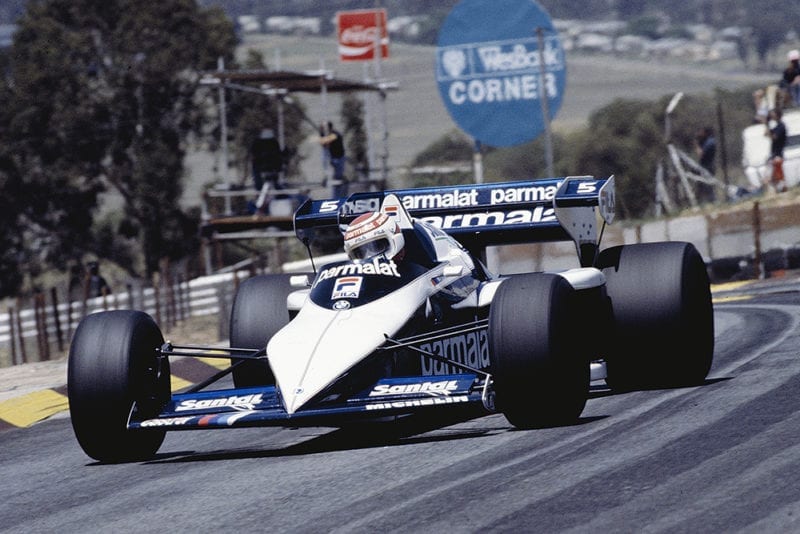
Brabham’s Nelson Piquet started on pole
Motorsport Images
Team Lotus started the weekend full of optimism, Nigel Mansell’s Renault-engined 95T fitted with Garrett turbochargers on the occasion while it was Elio de Angelis’s turn to use KKK units. The Englishman proved significantly quicker than his team-mate from the word go, eventually lining up third after a fine lap in 1 minute 05.125 sec. By the end of the first qualifying session de Angelis clearly wasn’t very pleased about this disparity of performance and, as a result, his 95T was fitted with Garrett turbochargers in time for the second day’s practice. The Italian improved his time by four-tenths to 1 min 05.953 sec to qualify seventh.
After his disappointment in the Brazilian Grand Prix, where the combination of a leaking fuel cell and a cracked turbocharger intercooler resulted in his RE50 grinding to a halt, apparently out of fuel, a few laps before the finish, Patrick Tambary was full of optimism at Kyalami. His car fitted with big Garrett turbochargers for qualifying purposes, the amiable Frenchman set third quickest time in the first session and felt he could have got the Renault onto the front row of the grid if he hadn’t been inadvertently baulked at the very fast Jukskei kink in the final hour of qualifying. His 1 min 05.339 sec eventually earned him fourth place on the grid, five positions ahead of team-mate Derek Warwick.
After the English driver’s late-race disappointment in Brazil, practice at Kyalami suggested he might be locked into a run of bad luck. Throughout qualifying he was in trouble with low turbo boost pressure and the car seemed to be reluctant to pull cleanly from low revs. He also found himself held up by other cars on both his runs on soft qualifying rubber, and on the second day he lost turbo boost pressure right at the end of the timed session with the result that he couldn’t improve on 1 min 06.506 sec.
In the McLaren International camp there was a brand new spare car on hand for the first time. The crated spare monocoque which had been on hand in Brazil had been airfreighted back to Britain and built up into a complete spare car, numbered MP4/2-3. it was given its first warm-up in Prost’s hands in the Thursday untimed session at Kyalami during which the gear linkage came adrift and the McLaren stopped out on the circuit, smouldering gently as a turbocharger heat-shield briefly caught alight. At the wheel of their two regular race cars during timed qualifying, both Prost and Lauda complained of intermittent misfires between 7,000 and 8,000 rpm, stemming from the difficulties involved in adapting the Bosch Motronic injection system to run cleanly at Kyalami’s 5.300 ft altitude.
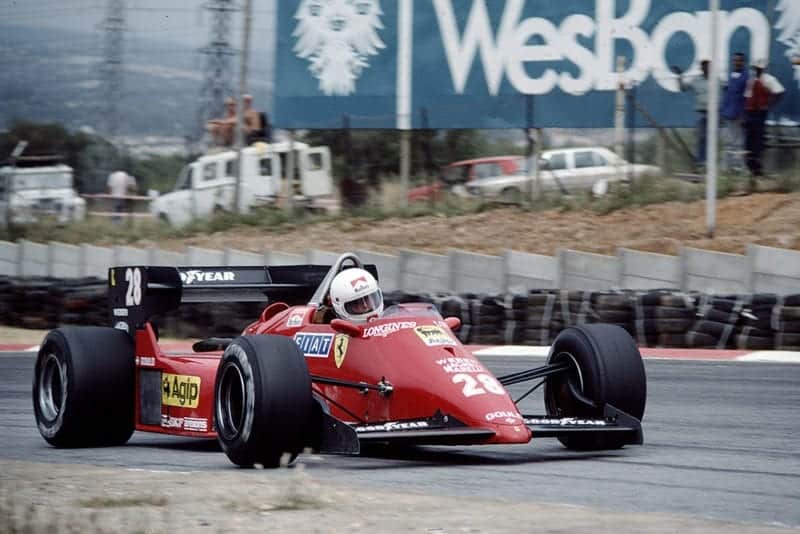
Rene Arnoux qualified a disappointing 15th for Ferrari
Motorsport Images
Prost eventually wound up fifth on 1 min 05.354 sec, fractionally slower than the unobtrusive Teo Fabi’s best at the wheel of the second Brabham BT53. He used the spare car to set this time, fitted with more responsive smaller turbochargers than his race machine, and Lauda lagged behind slightly in eighth place on 1 min. 06.43 sec. Both drivers were extremely optimistic about the performance of their McLarens, feeling that they might not be potential challengers for pole position, but that the MP4/2s would be highly competitive propositions when it came to a race over 200 miles or so.
This confidence was in no way shared by the Ferrari team whose two drivers Michele Alboreto and René Arnoux spent most of the two timed qualifying sessions grappling with chassis that seemed tormented by unpredictable handling and lack of traction out of Kyalami’s two tight corners. Screwing on additional downforce to enable the cars to generate reasonable traction out of Leeukop corner out on onto the long start/finish straight simply left both drivers swamped by their rivals before they arrived at Crowthorne corner. If they “backed off” their aerofoils to develop any vestige of competitive straight line speed, the Ferraris slid round so alarmingly everywhere else on the circuit that they quickly blistered their Goodyear tyres. The best Ferrari qualifying time was Alboreto on 1 min 06.323 sec, earning tenth place on the grid (and only fractionally quicker than Tambay’s 126C3 pole position at the previous Kyalami race) while Arnoux looked completely at sea and could only record 1 min 07.345 sec which was 15th quickest, way down amongst the also-rans.
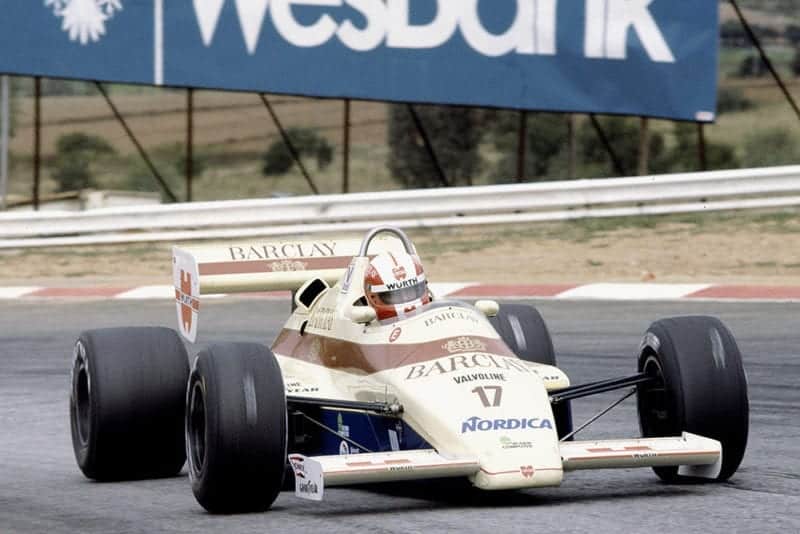
Arrows driver Marc Surer went through more tribulations 23rd on the grid
© Motorsport Images
Manfred Winkelhock handled his ATS D7 quite respectably to qualify as quickest of the Pirelli runners on 1 min 06.981 sec, the German relying on his new car throughout the weekend and retaining his older D6 only as a spare. Brazilian Formula 3 graduate Ayrton Senna was only fractionally slower on 1 min 06.981 sec, the South American newcomer displaying tremendous flair and determination throughout the two days of qualifying. Team-mate Jonny Cecotto was obliged to use the team’s spare TG183B during the two timed sessions after crashing his designated race car coming out the fast Barbecue corner during Thursday’s untimed practice session. Those qualifiers between the two Toleman drivers on the starting grid included Andrea de Cesaris’s Ligier JS23, Arnoux, Eddie Cheever in the faster of the two Alfa Romeo 184Ts, François Hesnault in the second Ligier and Riccardo Patrese in the second Alfa which was bugged by a leaking turbocharger during the final session and misfired its way round for the entire hour.
Mauro Baldi in the neat “Ferrari lookalike” Spirit 101B was just pipped by Piercarlo Ghinzani’s Osella-Alfa, while the last few rows were completed by the Hart 415-engined RAMs of Philippe Alliot and Jonathan Palmer, while Stefan Bellof’s Tyrrell 012 and Marc Surer’s Arrows A6 had the benefit of a “tow” from their friend Manfred Winkelhock which enabled them to slip into the race just ahead of Englishman Martin Brundle’s Tyrrell 012. This left Thierry Boutsen’s Arrows A6 as the only official non-qualifier, but when Ghinzani crashed his Osella spectacularly at the Jukskei kink mid-way through the race morning untimed session, Boutsen found himself promoted into the race The Italian driver was extremely fortunate to escape from this spectacular accident, but although the Osella erupted into flames, the driver’s cockpit was largely undistorted and Ghinzani was rescued very promptly thanks to the intervention of several brave marshals and some other drivers who stopped at the scene. Although he was taken to hospital, initial worries that he had broken his right arm proved premature and the good news was that, although he’d incurred some nasty burns to his neck and eyebrows, he had survived without any fractures. The car was totally wrecked.
Race
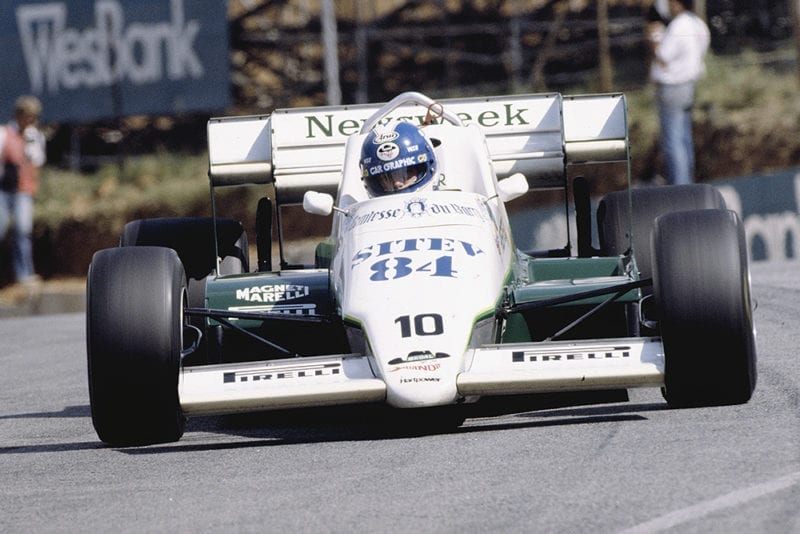
Jonathan Palmer lasted until lap 22 with gearbox issue
Motorsport Images
As the 26 starters lined up on the dummy grid just prior to the start, there was something of a major panic surrounding Prost’s McLaren on the inside of the third row. The bodywork was taken off and mechanics were swarming all over the car, desperately trying to coax it into life. Eventually the whole project was abandoned, the race car pushed to the side of the circuit and Prost sprinted over the pit lane where he was immediately strapped into the team spare. The problem seemed to be a reluctance on the part of the engine to run when the electric fuel pump was switched off: the speculation was that the pre-cooled fuel might have frozen in the fuel lines, but there was no time for a detailed and thorough diagnosis. Prost cruised down to the end of the pit lane while the remainder of the grid went off on its parade lap. The Formula One regulations state that any car failing to take its proper position on the dummy grid must start from the pit lane after the rest of the field has started. Unfortunately, a well-meaning official waved Prost onto the circuit and he chased round to join up the main grid proper: seeing this, the official involved indicated that the start would be delayed as Prost was sent back into the pit lane once again and the whole “count down” began again.
When the green light was finally given, Piquet’s pole position Brabham briefly went “off the boil” and for a few agonising seconds it seemed as though the World Champion was about to stall his car for the second successive race. Rosberg’s Williams went charging away down the hill towards Crowthorne as Mansell’s Lotus 95T zig-zagged through from the second row, briefly to snatch second place as the field went under the bridge beyond the pits. Mansell’s machine suddenly hesitated, dropping back into the middle of the seething pack, while Piquet got his BMW engine “on cam” and simply rocketed back into second place, amazingly, by the time the field had arrived at the first corner.
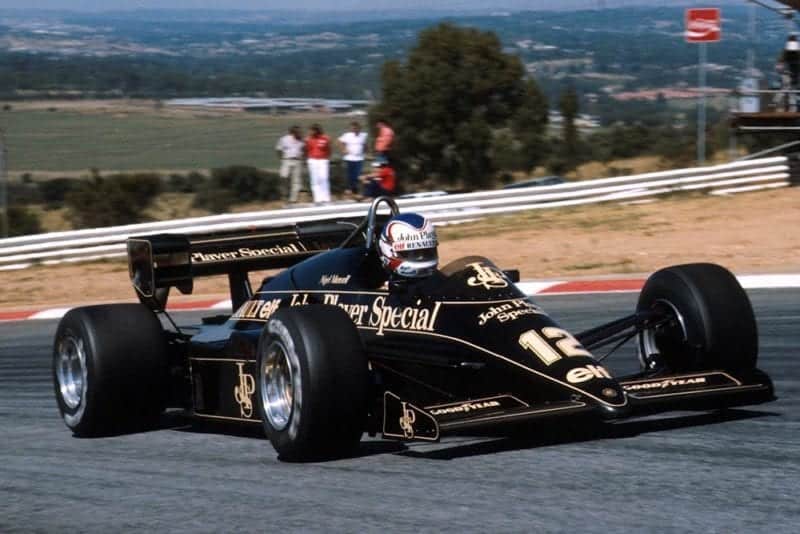
Nigel Mansell retired with a turbo issue on lap 51
Motorsport Images
Rosberg knew full-well that he’d been handed an unexpected bonus, but he couldn’t have imagined the way in which Piquet’s Brabham gobbled up his advantage as they sped round that opening lap. Up into Leeukop, the climbing right-hander which leads out onto the start / finish straight, the Brabham-BMW was crawling all over the Williams and Piquet pulled out and surged through into the lead as the two cars crested the rise just beyond the pit entrance as they completed their first tour.
On the second lap Teo Fabi’s sister Brabham BT53 surged through into second place and Ecclestones’s two sleek blue and white cars quickly pulled away from the remainder of the field, Rosberg holding up the remainder of the field in tight formation. Lauda’s McLaren was a strong fourth at the end of the opening lap and only took until lap four before he streaked ahead of the Williams to begin chasing the two Brabhams at the head of the field.
By the end of lap 10 Lauda had closed in on Fabi’s BT53, relieving the Italian of second place as they ran down towards Crowthorne: the speed of Fabi’s car was such that he almost had sufficient impetus to nip back ahead of the Austrian as they rushed down to the first corner. But the eagle-eyed Austrian wasn’t having that and gently eased over to the middle of the track in an effort to dislodge the second Brabham from his slipstream. Once he’d successfully arrived at the corner ahead, Lauda was so much quicker than his rival down the hill through Barbecue and Jukskei that he had no further trouble from the new Brabham recruit.
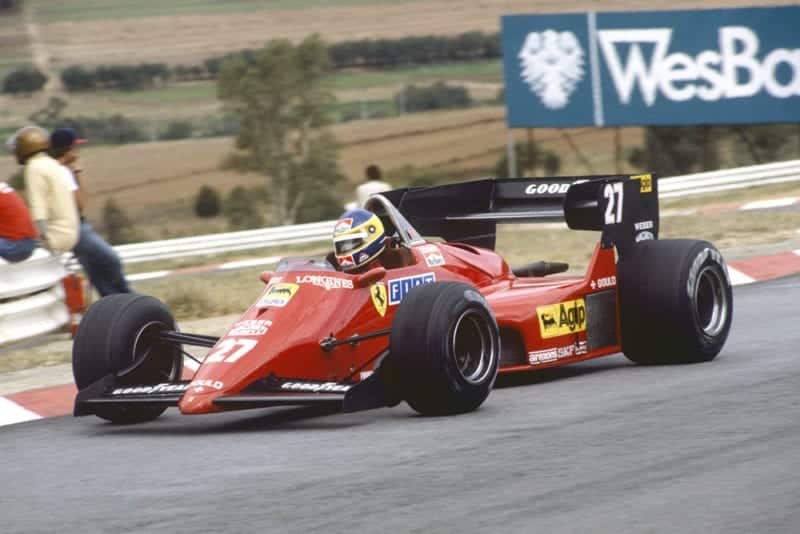
Michele Alboreto’s race ended on lap 70 with ignition trouble
Motorsport Images
Both Brabhams had started on a marginal choice of Michelin rubber, bearing in mind the fact that they were both running with a full fuel load and setting a very fast pace in the race’s opening stages. Initially it seemed as though Piquet might be able to sustain his advantage, but as Lauda got into his stride it quickly became clear that the Porsche-engined McLaren was every bit a match for the BMW-engined Brabham. Slowly but surely the 35-year old Austrian veteran eased his way up onto Piquet’s tail and, as the World Champion realised that his tyres were finished, he pulled off into the pit lane for fresh Michelins at the end of lap 21. From that point onwards Lauda was never challenged as Piquet lasted only another eight laps on fresh tyres before succumbing to a turbocharger malfunction.
For the remainder of the race there were two distinct aspects to consider. Firstly, the McLaren-Porsche performance, both in the hands of Niki Lauda and his team mate Alain Prost. Lauda’s performance was a copy book demonstration of precisely why the Austrian has won so many races in his decade-long Grand Prix career: he was smooth, and predictable to the point of boredom, whilst at the same time tremendously quick. It’s worth considering the while Prost started from the pit lane, some twenty seconds or so behind the main grid, at the end of the race he was more than a minute (and the best part of a lap) behind Lauda. Even allowing for the fact that Prost had to fight his way through the field, passing cars with smooth precision on every lap, one is bound to speculate that he would have had a hard time matching Lauda even if he’d been able to start from his original grid position on the third row.
Behind the two victorious McLaren-Porsches, the rest of the grid was left to scrap over the remaining positions. Rosberg’s Williams was gradually worn down by the opposition and eventually retired with a failed driveshaft constant velocity joint, leaving Derek Warwick’s Renault to run through to third place, despite one scheduled stop for tyres and a second when he had a punctured rear Michelin on that replacement set. Despite all these tribulations, he raced determinedly with Alboreto’s Ferrari C4 (which was intent on running the race non-stop) and actually passed the Italian car twice (after each of his pit stops) under hard braking for Crowthrone corner. Towards the end of the race it seemed as though Alboreto might take a steady fourth, but with 70 laps completed he coasted to a standstill with the same “fuel vapourisation” problems that had sidelined his team mate René Arnoux much earlier in the contest.
Behind Warwick the finishing order was very much a question of survival: Riccardo Patrese’s Alfa Romeo 184T finally emerged fourth, but he was over five miles behind the winner (two laps down). Andrea de Cesaris lasted to finish fifth after an unimpressive showing in his Ligier JS23, while young Brazilian rising star Ayrton Senna kept his head down at the wheel of his Toleman TG183B and emerged sixth, despite losing part of his car’s nose section in the heavy traffic on lap three.
Elio de Angelis’s Lotus 95T was hanging on to the leading bunch in the early stages and briefly ran as high as second before making his scheduled pit stop, only to return to the pits with a deranged throttle linkage a lap after stopping for new tyres. The problem was eventually sorted out but there was no way in which the Italian driver could regain his lost ground and he finally finished a very disappointed seventh. Nigel Mansell’s similar car never featured after his early loss of places on the opening lap and eventually retired when the carbon fibre plenum chamber cracked and his engine lost turbocharger boost pressure.
One of the biggest disappointments occurred when Jacques Laffite’s Williams FW09 shed its right rear wheel as it negotiated the Esses on lap 61, the wheel securing nut coming off and leaving the Frenchman to slither to an undignified halt at the side of the circuit. At this juncture Laffite, another driver intending to run non-stop, had been well placed behind the McLarens and was displaying more flair than we’ve seen for some time.

Lauda takes the chequered flag
Motorsport Images
Behind de Angelis the only other cars running at the chequered flag were Mauro Baldi’s Spirit-Hart, the Arrows A6s of Surer and Boutsen, Hesnault’s Ligier JS23 and Martin Brundle’s Tyrrell. Stefan Bellof’s Tyrrell had skated off into the dirt at Crowthorne after encountering a braking problem, while Brundle had charged into the right rear wheel of Hesnault’s Ligier at Leeukop as he tried to find a way past the obstructive Frenchman.
The English novice lost a lot of time in the pits having a new nose section fitted, but at least he was still running at the finish. Small consolation, one might think, being four laps behind those impressive McLaren-Porsches. But on the other hand, at least he managed to keep running: something that Brabham, Williams and Ferrari singularly failed to do out of the leading teams, not to mention RAM and ATS. Patrick Tambay’s Renault RE50 ground to a halt in the closing stages as well, the French driver apparently stricken with a repeat of his Brazilian frustration: this time, however, the problem proved to be a faulty fuel metering unit which was consuming his precious Elf petrol at a dramatic rate, preventing him from lasting the full 75 lap distance. He wasn’t amused, but then neither were Piquet, Rosberg, Laffite or Fabi. At the other end of the scale, Niki Lauda and Alain Prost looked quietly content, their demeanour shared by their colleagues from McLaren, Porsche, Bosch and Michelin! – A.H.
